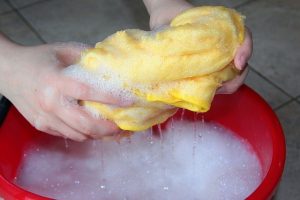 Are you conflicted by the beckoning call for mood-lifting springtime activity and a nagging need to tackle spring-cleaning? This never-ending debate between self-care and responsibility is a common theme amongst adults. Before you throw in the towel on self-care, enlighten yourself with ideas to enjoy the best of both worlds.
Are you conflicted by the beckoning call for mood-lifting springtime activity and a nagging need to tackle spring-cleaning? This never-ending debate between self-care and responsibility is a common theme amongst adults. Before you throw in the towel on self-care, enlighten yourself with ideas to enjoy the best of both worlds.
Maximize movement opportunities for a clean home and fit body
In a given day, more opportunities exist for movement than for exercise. Therefore, movement represents a large chunk of the calories used for physical activity, if you make the conscious effort to move. As you go about spring-cleaning, emphasize a wide range of movements for a full-body workout and the joy of a clean home! Get everyone in the family involved. Safety tip: listen to your body and never push movement to the point of pain.
- Use large and small arm circles to clean windows, alternate clock-wise and counter clock-wise motions, at varying speeds. (Arms)
- Dust in high places using a small stepladder. Prior to starting, take 8 – 12 vertical steps, alternating lead leg. (Legs)
- As you pack away winter clothes, lift each piece of clothing above your head before putting in the box. (Shoulders/back)
- Rake (shovel) with gusto! Switch sides of the body in which you pull the rake towards. (Core/arms/back)
- In lieu of a mop, use legs to push/pull a damp towel across a floor. Alternate legs, and move them in all directions. Hold on to tables and walls as needed for balance. (Legs/core)
- Don’t forget to hydrate. Pause between tasks for a sip of plain, sparkling or infused water.
- Wrap up spring-cleaning with gentle stretching
Movement over exercise for achievable health outcomes
Your body needs energy in the form of calories, which we get from food and beverage. In fact, 60% of the calories your body needs are for basic functioning. Consider basic functioning as the energy used to keep your heart beating, lungs breathing, kidneys filtering and so forth. It’s the minimal amount of energy expended known as resting metabolic rate (RMR).
Converting food into energy takes energy. Digestion accounts for about 10 – 15% of your caloric needs. That leaves up to 25 – 30% of your daily caloric needs unaccounted for. How does the body put these calories to use? The answer, physical activity. 
Physical activity consists of movement and exercise, which are distinct. Exercise consists of planned periods of intense activity resulting in an increased heart rate. Examples include swimming, hiking, biking, or Zumba. Typically, exercise takes place in short blocks of time, a few days a week, if at all. This is the form of physical activity most struggle with making time for. In other words, it uses up relatively few of the calories dedicated to physical activity.
Movement on the other hand, is unplanned, unstructured and occurs sporadically throughout the day. Examples include walking from the car to the store, standing instead of sitting, and cleaning house. Another term for movement is N.E.A.T., non-exercise activity thermogenesis. The feasibility of engaging in it daily translates into a positive health impact.

